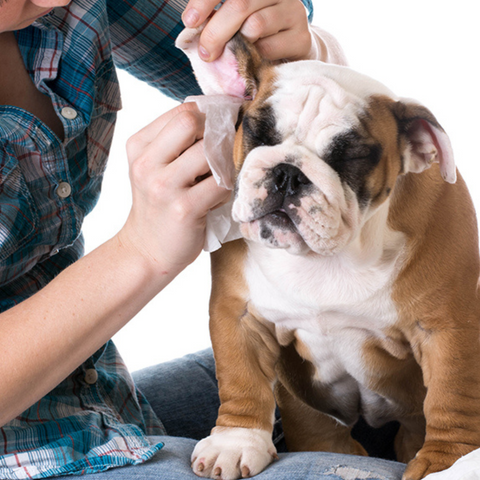
Are you concerned about your furry friend's constant scratching, head shaking, or ear discharge? It could be a sign of ear mites, a common issue among dogs. Understanding the symptoms and proper treatment is crucial to ensure your pup's comfort and prevent complications. In this comprehensive guide, we will walk you through everything you need to know about ear mites in dogs.
Ear mites are tiny parasites that invade dogs' ears, causing irritation and discomfort. Common symptoms include intense itching, dark waxy discharge, and frequent shaking of the head. If left untreated, ear mites can lead to ear infections and even hearing loss.
Identifying the signs of ear mites is the first step towards seeking appropriate treatment. Our guide will help you accurately identify these pesky critters and differentiate them from other ear problems. Furthermore, we will explore various treatment options, from over-the-counter medications to natural remedies, providing you with the knowledge to make the best decision for your dog's well-being.
Say goodbye to your furry friend's ear discomfort – join us as we delve into the world of ear mites and equip you with the tools to recognize and treat them effectively.
What are ear mites?
Are you concerned about your furry friend's constant scratching, head shaking, or ear discharge? It could be a sign of ear mites, a common issue among dogs. Understanding the symptoms and proper treatment is crucial to ensure your pup's comfort and prevent complications. In this comprehensive guide, we will walk you through everything you need to know about ear mites in dogs.
Ear mites are tiny parasites that invade dogs' ears, causing irritation and discomfort. Common symptoms include intense itching, dark waxy discharge, and frequent shaking of the head. If left untreated, ear mites can lead to ear infections and even hearing loss.
Recognising the signs of ear mites is the first step towards seeking appropriate treatment. Our guide will help you accurately identify these pesky critters and differentiate them from other ear problems. Furthermore, we will explore various treatment options, from over-the-counter medications to natural remedies, providing you with the knowledge to make the best decision for your dog's well-being.
Say goodbye to your furry friend's ear discomfort – join us as we delve into the world of ear mites and equip you with the tools to recognise and treat them effectively.
How do dogs get ear mites?
Ear mites, also known as Otodectes cynotis, are tiny parasites that infest the ears of dogs. These mites are highly contagious and can easily spread from one animal to another through close contact. Ear mites are more commonly found in cats, but they can also affect dogs.
Ear mites are extremely small, measuring only about 1/32 of an inch in length. They have a lifespan of about three weeks and spend their entire lives inside the ear canals of their hosts. These mites feed on the wax and oils in the ears, causing irritation and discomfort.
Contrary to popular belief, ear mites are not visible to the naked eye. However, their presence can be detected through the symptoms they cause. If your dog is displaying signs of persistent itching, head shaking, or excessive scratching around the ears, it's likely that ear mites are the culprit.
To confirm the presence of ear mites, a veterinarian will need to perform a thorough examination of your dog's ears. They may use an otoscope to visualize the mites or take a sample of the discharge for further analysis. Once diagnosed, prompt treatment is essential to alleviate your dog's discomfort and prevent the spread of mites to other pets or humans.
Symptoms of ear mites in dogs
Dogs can contract ear mites through various means, the most common being direct contact with an infected animal. This can occur during social interactions at parks, kennels, or even within the household if you have multiple pets. Ear mites are highly contagious and can easily transfer from one dog to another through close physical contact.
It's important to note that ear mites can also survive off the host for a short period. This means that objects such as bedding, grooming tools, or even furniture that came into contact with an infected animal can harbor mites and contribute to the spread of the infestation.
Additionally, young puppies are particularly susceptible to ear mite infestations, as their immune systems are not fully developed. Puppies can acquire mites from their mother, who may be an asymptomatic carrier, or from other infected dogs in the same environment.
To minimise the risk of ear mites, it's crucial to maintain good hygiene practices for your pets. Regularly cleaning their ears and keeping their living areas clean can help prevent the spread of mites. If you suspect that your dog has been exposed to ear mites, it's essential to seek prompt veterinary care to prevent the infestation from worsening.
Diagnosing ear mites in dogs
Ear mites can cause a range of symptoms in dogs, which can vary in severity depending on the individual and the stage of infestation. While some dogs may only display mild discomfort, others may experience intense itching and irritation. Here are some common symptoms of ear mites in dogs:
1. Intense itching and scratching: Dogs with ear mites will often scratch their ears vigorously, sometimes to the point of causing injury. This is due to the irritation caused by the mites feeding on the ear wax and oils.
2. Head shaking: Dogs with ear mites will frequently shake their heads in an attempt to alleviate the discomfort. This can be a telltale sign of an ear mite infestation.
3. Dark waxy discharge: Ear mites produce a dark, crumbly discharge that resembles coffee grounds. This discharge may be visible inside the ear canal or on the outer ear.
4. Redness and inflammation: The presence of ear mites can cause the ear canal to become red and inflamed. This can further contribute to the discomfort experienced by the dog.
5. Hair loss around the ears: Dogs with ear mites may experience hair loss around the ears due to excessive scratching and irritation.
It's important to note that the symptoms of ear mites can often be mistaken for other ear problems, such as bacterial or yeast infections. Proper diagnosis by a veterinarian is crucial to ensure appropriate treatment.
Treating ear mites in dogs
If you suspect that your dog has ear mites, it's essential to seek veterinary care for a proper diagnosis. A veterinarian will perform a thorough examination of your dog's ears, using an otoscope to visualize the ear canal and look for signs of mites.
During the examination, the veterinarian may also take a sample of the discharge for microscopic analysis. This allows them to confirm the presence of ear mites and rule out other potential causes of the symptoms.
In some cases, the veterinarian may recommend additional tests, such as a bacterial culture or a fungal culture, to determine if there are any secondary infections present. This information will help guide the treatment plan and ensure the best outcome for your dog.
It's important not to attempt to diagnose or treat ear mites on your own, as using improper treatments or medications can worsen the condition or cause harm to your dog. Always consult with a veterinarian for an accurate diagnosis and appropriate treatment options.
Preventing ear mites in dogs
Treating ear mites in dogs typically involves a multi-faceted approach that targets both the mites and any secondary infections that may be present. Here are some common treatment options that your veterinarian may recommend:
1. Prescription medications: Depending on the severity of the infestation and any concurrent infections, your veterinarian may prescribe topical or oral medications to eliminate the mites and alleviate the symptoms. These medications may include ear drops, antiparasitics, or antibiotics.
2. Cleaning the ears: Regularly cleaning your dog's ears can help remove the waxy discharge and debris associated with ear mites. Your veterinarian will provide specific instructions on how to clean the ears safely and effectively.
3. Environmental management: To prevent re-infestation, it's important to thoroughly clean your dog's living areas and wash any bedding, toys, or grooming tools that may have come into contact with the mites. Vacuuming the house and treating the environment with appropriate insecticides may also be necessary.
4. Follow-up appointments: It's crucial to follow up with your veterinarian as recommended to monitor your dog's progress and ensure that the treatment is effective. In some cases, additional treatments or adjustments to the treatment plan may be necessary.
In addition to conventional treatment options, some dog owners may opt for natural remedies or alternative therapies. While these approaches may provide some relief, it's important to consult with a veterinarian before using any alternative treatments to ensure their safety and effectiveness.
Preventing ear mites is easier than treating an infestation. Here are some measures you can take to reduce the risk of your dog contracting ear mites:
1. Regular ear cleaning: Keeping your dog's ears clean and free from excessive wax and debris can help prevent the buildup that attracts mites. Use a veterinarian-approved ear cleanser and follow the recommended cleaning frequency.
2. Maintain good hygiene: Regularly groom your dog, including brushing their coat and trimming the hair around the ears. This helps prevent the accumulation of dirt and wax, which can provide a favorable environment for mites.
3. Avoid contact with infected animals: If you know or suspect that an animal has ear mites, avoid allowing your dog to come into close contact with them. This includes interactions at parks, kennels, or other social environments.
4. Regular veterinary check-ups: Regular wellness exams allow veterinarians to detect and address any potential health issues, including ear mites, at an early stage. Routine check-ups help ensure that your dog's overall health is maintained.
In multi-pet households, it's important to treat all animals simultaneously if one is diagnosed with ear mites. This prevents the mites from spreading and re-infesting the treated pet.
©deliveryhound.com.au 2023






